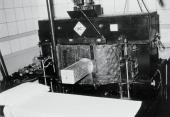
Saskatchewan has been a world leader in the fight against cancer. The Saskatchewan Cancer Commission Act, passed by the Conservative government of J.T.M. Anderson in 1930, established the first cancer control agency in Canada in 1930. North America's first government-sponsored, government-equipped, part-time diagnostic and treatment clinics were staffed by radiologists: Dr. Earle E. Shepley at the Saskatoon City Hospital, and Dr. Clarence M. Henry at the Regina General Hospital. Patients were treated with “high-voltage” machines, operating at 400 kilovolts peak, and with radium. In 1931, Dr Shepley visited Dr. Ellice McDonald (who had been raised at Fort Qu'Appelle, Saskatchewan, and had graduated in medicine from McGill University in 1901) at the Cancer Institute in Philadelphia, as well as Dr. James Ewing at the New York Memorial Hospital. On Shepley's return, the Saskatchewan government allocated $115,000 for the purchase of radium. From a radon plant at the University of Saskatchewan, Dr. Ertle Harrington distributed radon to both cancer clinics in small gold tubes or “seeds.”
In 1939, Regina-born Dr. Allan W. Blair, a graduate of McGill University and a radiotherapist at the Toronto General Hospital, became director of the Regina cancer clinic. The first session of the CCF legislature in October 1944 passed the Cancer Control Act, which provided all services necessary for the diagnosis and treatment of cancer without charge. Dr. Blair recognized that a full-time radiation physicist was needed. In 1945, Dr. Harold E. Johns was hired jointly by the Saskatchewan Cancer Commission and the university, and thus became Canada's first full-time cancer physicist. A 24-MeV betatron, manufactured in Wisconsin, purchased for $80,000, was installed at the University of Saskatchewan, and nine months were spent in its meticulous calibration before the first patient was treated on March 29, 1949. Over the next seventeen years, 301 patients were treated. They were delivered a high dose of radiation, without appreciable damage to overlying skin and with few side effects, but the operating costs of the betatron were high. This represented the first concerted clinical use of the betatron anywhere.
Most important of all, Saskatchewan initiated the first use of calibrated cobalt-60 in the world. In July 1949, after visiting the Chalk River Experimental Nuclear Reactor Facility in Ontario, Dr. Harold Johns asked University of Saskatchewan president Walter P. Thompson for 1,000 curies of cobalt-60, about 100 times the activity of any radium unit. After gaining the assent of Premier and Health Minister Douglas, Johns applied for Chalk River's first cobalt source, 2.5 cm in diameter, 1.25 cm thick, with an approximate strength of 1,000 curies. The 0.9 tonne Saskatoon unit, designed by Johns and Lloyd Bates and built by Johnny MacKay, was installed in the newly constructed cancer wing of University Hospital on August 17, 1951. McKay also built the collimation apparatus - interchangeable lead plugs - to direct the radiation to a precise area. Rigorous measurements were continued until November 8, 1951, when the first patient was treated by Watson (see Table HCT-1 below).
The first patient treated at Saskatoon had advanced carcinoma of the cervix at age 40. She received a precise dose to an exact area, carefully calibrated. Not only was she cured of her cancer, but she lived to the age of 90 in Victoria, British Columbia. The first formal publication giving details of cobalt therapy was written by H.E. Johns, L.M. Bates, E.R. Epp, D.V. Cormack, and S.O. Fedoruk, all from Saskatchewan, with three University of Saskatchewan physics graduates (A. Morrison, W.R. Dixon, and C. Garrett) working at the National Research Council in Ottawa. The depth-dose charts compiled by Epp, Fedoruk, and Johns were used in active radiotherapy departments throughout the world.
MacKay's small firm in Saskatoon produced over 100 collimators for Picker Cobalt units that were distributed internationally. The original Saskatoon cobalt-60 unit treated 6,728 patients over the age of 21, until finally it was replaced by a commercial AECL cobalt-60 machine in 1972. Saskatchewan had been first in this effective and more economical method of treating cancer, still so inexpensive that Cobalt-60 remains widely used in less affluent countries.
C. Stuart Houston, Sylvia O. Fedoruk
Print EntryHOME | BROWSE BY SUBJECT | ENTRY LIST (A-Z) | IMAGE INDEX | CONTRIBUTOR INDEX | ABOUT THE ENCYCLOPEDIA | SPONSORS TERMS OF USE | COPYRIGHT © 2006 CANADIAN PLAINS RESEARCH CENTER, UNIVERSITY OF REGINA | POWERED BY MERCURY CMS |
|||
| This web site was produced with financial assistance provided by Western Economic Diversification Canada and the Government of Saskatchewan. |
|||
 |
 |
 |
 |
| Ce site Web a été conçu grâce à l'aide financière de Diversification de l'économie de l'Ouest Canada et le gouvernement de la Saskatchewan. |
|||